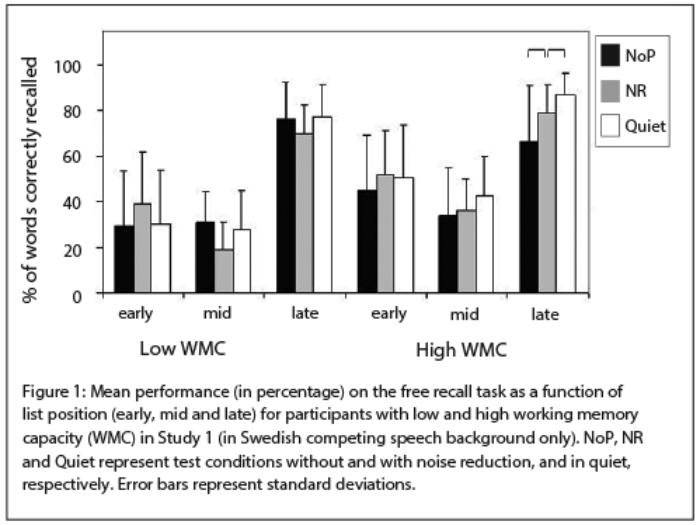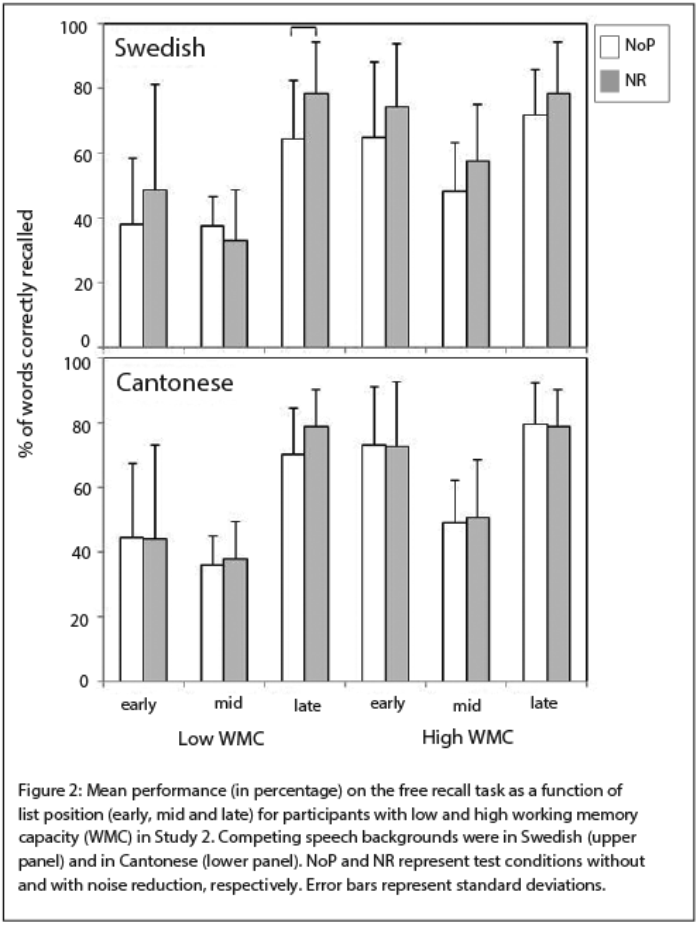Introduction
Hearing aids are designed to provide amplification for individuals with poor auditory sensitivity. Signal processing algorithms are designed and implemented in hearing aids to further enhance speech intelligibility and to improve listening comfort by attenuating unwanted background noise. Sarampalis et al. [1] showed that, using a free recall paradigm, a hearing aid noise reduction algorithm improved memory for highly intelligible speech (close to 100% speech perception) and reduced listening effort. However, this effect has only been reported in younger adults with normal hearing, not in hearing aid users.
Cognitive abilities, which vary between individuals, have been shown to be related to speech understanding in challenging conditions and influence the ability to benefit from hearing aids. For instance, working memory, which is the capacity for the simultaneous storage and online processing of information, is one of the most important cognitive abilities in speech understanding. Individual differences in working memory capacity are shown to be linked to differences in unaided and aided speech recognition performance in noise, success with hearing aid signal processing, and hearing aid benefit [2-4].
Two studies (Study 1 and Study 2) were carried out to investigate the role of cognition in hearing aid users. The specific aims of the studies were 1) to investigate whether hearing aid signal processing would affect memory for heard speech and 2) to test whether the effects of signal processing on the ability to recall speech would interact with background noise and individual differences in working memory capacity.
Method
In each study, 26 native Swedish speakers were recruited. All participants were between 32 and 65 years old, had symmetrical moderate to moderate-severe sensorineural hearing loss and were experienced hearing aid users. Two tests were administered. The first test was the reading span test, which measures working memory capacity [5]. Two subgroups of participants were formed based on the reading span test scores (high and low working memory capacity groups, 13 participants in each group). The second test was the Sentence-final Word Identification and Recall (SWIR) test [6], which measures the effects of noise and a noise reduction algorithm on memory for speech in hearing aid users. A noise-reducing signal processing scheme called binary time-frequency masking [7] was used in the studies. An individualised signal-to-noise ratio yielding 95% speech recognition in noise was applied to all test conditions for each participant. This was done to ensure that the auditory speech stimuli were highly intelligible. The SWIR test consisted of two tasks performed in sequence. Participants listened to lists of sentences in different types of background noise; there were eight and seven sentences in a list in Study 1 and Study 2, respectively. The first task was an identification task, in which participants repeated the sentence-final word immediately after hearing it. Once the words in a list had been identified, listeners completed the second task, a free recall task, in which participants recalled in any order the sentence-final words they had identified.
Study 1
This study aimed to examine the effects of noise reduction on memory processing for speech perceived in quiet, in stationary noise, and in a competing speech background. The role of individual differences in working memory capacity was also investigated.

There was an effect of noise on memory for people with hearing impairment, such that recall of heard speech declined with background noise despite high intelligibility. There was no effect of noise reduction when the background was stationary noise. For the competing speech background, noise reduction reduced the adverse effects of noise on memory for individuals with high working memory capacity, but there was no effect for individuals with low working memory capacity. Figure 1 shows mean recall performance of the SWIR test in the competing speech background. Moreover, noise reduction improved memory for words occurring in the last few sentences in a list (late list position).
Competing speech may be more detrimental to recall performance than stationary noise because the lexical information in competing speech was more distracting [8] and was harder to segregate from target speech [9]. Segregation of target words from background noise may be facilitated when there is noise reduction. This would allow more rapid and accurate word identification and enhance encoding of words into working memory [10]. Importantly, the results of this study also showed that the effect of signal processing on memory depends on individual differences in working memory capacity.
Study 2
In this study, the effects of noise reduction on memory found in Study 1 were further investigated using a modified version of the SWIR test. The modifications were designed to make the test less cognitively demanding. In addition, the effects of masker language were studied. Competing speech backgrounds in Swedish (native language) and Cantonese (foreign language) were used. None of the participants were familiar with Cantonese.

A main effect of noise reduction was found for the Swedish background (p<0.01), indicating that noise reduction improved memory recall. Figure 2 shows mean recall performance on the SWIR test. Results showed that noise reduction improved memory for words heard in noise. Interestingly, this effect was found irrespective of working memory capacity. When the test is less demanding (Study 2), it appears that the effect of individual differences in working memory capacity on task performance is lessened. For the individuals with limited capacity, the modified test presumably did not fully exhaust their cognitive resources, and therefore they had sufficient cognitive capacity to accomplish the task. Under these conditions, it was more likely for them to benefit from noise reduction.
The effect of noise reduction occurred in the late list position only for individuals with low working memory capacity, while it seemed to be rather evenly distributed across serial positions in the list for individuals with high working memory capacity. Thus, the findings of this study also suggest that the effect of noise reduction is modulated by individual differences in working memory capacity.
Recall performance was more disrupted by the native language masker than the unintelligible foreign language masker. When noise reduction was applied, the effect of the native language masker was reduced to that of the foreign language masker. One possible mechanism is that noise reduction facilitated segregation of the target native speech from native speech babble.
Conclusions
Both studies showed that noise reduction freed up cognitive resources and reduced the adverse effect of noise on recall performance. In particular, this effect was found when speech stimuli were presented in a background of speech babble spoken in the listener’s native language. The possible underlying mechanisms are that noise reduction facilitates auditory stream segregation between target and irrelevant speech in noise and reduces the attention captured by the linguistic information in irrelevant speech. The effects of noise reduction and memory performance were modulated by individual differences in working memory, which suggests that working memory capacity interacts with hearing aid signal processing.
References
1. Sarampalis A, Kalluri S, Edwards B, et al. Objective measures of listening effort: effects of background noise and noise reduction. J Speech Lang Hear Res 2009;52(5):1230-40.
2. Gatehouse S, Gordon J. Response times to speech stimuli as measures of benefit from amplification. Br J Audiol 1990;24(1):63-8.
3. Lunner T. Cognitive function in relation to hearing aid use. Int J Audiol 2003;42(Suppl 1):S49–S58.
4. Moore BC (2008). The choice of compression speed in hearing AIDS: theoretical and practical considerations and the role of individual differences. Trends Amplif 2008;12(2):103-12.
5. Daneman M, Carpenter PA. Individual differences in working memory and reading. J Verb Learn Verb Behav 1990;19(4):450-66.
6. Ng EH, Rudner M, Lunner T, et al. Effects of noise and working memory capacity on memory processing of speech for hearing aid users. Int J Audiol 2013;52(7): 433-41.
7. Wang D, Kjems U, Pedersen MS, et al. Speech intelligibility in background noise with ideal binary time-frequency masking. J Acoust Soc Am 2009;125(4): 2336-47.
8. Sörqvist P, Rönnberg J. Episodic long-term memory of spoken discourse masked by speech: what role for working memory capacity? J Speech Lang Hear Res 2012;55(1):210-8.
9. Mattys SL, Brooks J, Cooke M. Recognizing speech under a processing load: dissociating energetic from informational factors. Cogn Psychol 2009;59(3):203-43.
10. Heinrich A, Schneider BA. (2011). Elucidating the effects of ageing on remembering perceptually distorted word pairs. Q J Exp Psychol 2011;64(1):186-205.
Declaration of Competing Interests: TL is partly employed by the Danish hearing aid manufacturer Oticon.




